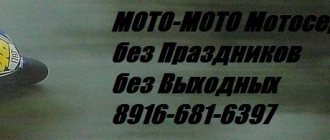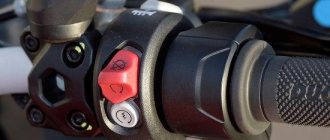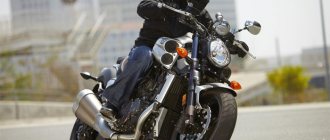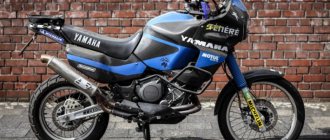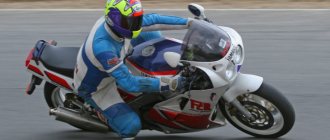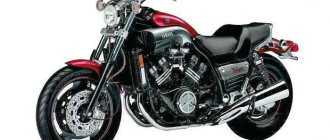- motorcycle model, Yamaha brand,
The model of the classic motorcycle Yamaha XJR 1200 appeared in 1994, and at the time of its release it was the most cubic “classic” among all Japanese motorcycle manufacturers. The model was mainly aimed at sales in European countries, but over the years the Yamaha XJR1200 was available on the Japanese and Australian markets.
The motorcycle was based on an in-line 4-cylinder air-cooled engine from the Yamaha FJ 1200, with a volume of 1188 cm³, producing 98 hp. power and 91 Nm of torque. Maximum motor characteristics are from 6000 to 8000 rpm. The engine has 2 camshafts and 4 valves per cylinder. Power supply system: carburetors.
Otherwise, the Yamaha XJR 1200 has a traditional layout for motorcycles of this class: a steel duplex frame, classic suspension in the form of a conventional telescopic fork and a double shock absorber at the rear, powerful disc brakes, a hydraulic clutch and a 5-speed gearbox.
In 1996, a limited version of the Yamaha XJR1200R was offered for the Japanese market, which was equipped with a half fairing. This modification did not gain wide popularity and disappeared from the line in the same year.
In 1997, the Yamaha XJR1200SP version appeared on the European market, which is distinguished by its original black, white and yellow coloring. This modification continued to be offered in parallel with the regular version until the end of production.
1998 was the last year of production of the Yamaha XJR1200, after which it was replaced by the new Yamaha XJR 1300.
Brief history of the model
1994 - official start of production and sales. Model: Yamaha XJR1200 (Japan). Factory designation: 4KG1.
1995 - no significant changes. Model: Yamaha XJR1200 (Japan, Europe). Factory designation: 4KG2, 4PU1, 4PU2, 4RB1.
1996 - appearance of the Yamaha XJR1200R modification. Model: Yamaha XJR1200R; Yamaha XJR1200 (Japan, Europe, Australia). Factory designation: 4KG3; 4KG4, 4PU3, 4PU4, 4RB2, 4UW1.
1997 - appearance of the Yamaha XJR1200SP modification. Model: Yamaha XJR1200; Yamaha XJR1200SP (Europe). Factory designation: 4PU7, 4PU8, 4RB4; 4PU5, 4PU6, 4RB3.
1998 is the last year of production. Model: Yamaha XJR1200; Yamaha XJR1200SP (Europe). Factory designation: 4PU9, 4PUA, 4RB5, 4UW2; 4PUB, 4PUC, 4RB6.
Specifications:
| Model | Yamaha XJR 1200 |
| Motorcycle type | road |
| Year of issue | 1994-1998 |
| Frame | steel tubular |
| engine's type | 4-cylinder, 4-stroke, in-line |
| Working volume | 1188 cm³ |
| Bore/Stroke | 77.0 x 63.8 mm |
| Compression ratio | 9.7:1 |
| Cooling | air |
| Number of valves per cylinder | DOHC, 4 valves per cylinder |
| Fuel supply system | carburetor, 4x Mikuni BS36 |
| Ignition type | digital TCI |
| Maximum power | 98.0 hp (72.0 kW) at 8000 rpm |
| Maximum torque | 91.0 Nm (9.2 kg-m) at 6000 rpm |
| Transmission | 5-speed |
| type of drive | chain |
| Front tire size | 130/70ZR17 |
| Rear tire size | 170/60ZR17 |
| Front brakes | 2 discs, 320 mm, 4-piston calipers Sumitomo - XJR1200 (Japan, Europe, Australia) 2 discs, 320 mm, 4-piston calipers Brembo - XJR1200 (Japan) |
| Rear brakes | 1 disc, 267 mm, 2-piston caliper |
| Front suspension | 43 mm telescopic fork, travel - 130 mm |
| Rear suspension | pendulum with two shock absorbers (preload adjustment), stroke - 110 mm |
| Motorcycle length | 2255 mm |
| Motorcycle width | 765 mm |
| Motorcycle height | 1120 mm |
| Wheelbase | 1500 mm |
| Seat height | 790 mm |
| Minimum ground clearance (clearance) | 135 mm |
| Acceleration to 100 km/h | 3.7 sec |
| Maximum speed | 230 km/h |
| Gas tank capacity | 21.0 l (including reserve - 4.5 l) |
| Motorcycle weight (dry) | 232 kg |
| Motorcycle weight (curb) | 255 kg |
Review of the Yamaha XJR 1200 motorcycle
A classic-type device, it would seem, should be a city car... either it’s not purely urban... or our city is not the same (St. Petersburg), it doesn’t like traffic jams, air-oil cooling after all. Some of you will say what kind of traffic jams are on the motorcycle??? There are such traffic jams that you can’t escape and you have to stand.
Weak wind protection, even though I have a windbreaker, at a speed of over 120 you begin to feel uncomfortable, after 150 it blows away, you have to hide behind what you have. I accelerated it to 195 km/h (according to the speedometer), then the limiter works (I have a purely Japanese version). Despite all the shortcomings in wind protection, the motorcycle confidently holds the road at any speed, most likely this is due to its weight (232 kg).
When I first approached the apparatus, the weight of 232 kg caused uncertainty and a slight trembling in the knees, but after the first 2 days of riding I forgot about its weight, now I don’t feel it at all. In traffic jams, if I get between cars, I’m no worse than 400 SS.
The engine of the device is very pleasant, there is enough torque to accelerate very intensively in any gear. For those who are in no hurry, you can put it in 5th gear and vomit at 60 km/h, at 2000 rpm, this also has its own thrill. Moreover, even from 60 km/h in 5th gear, when turning the gas, the device begins to accelerate with quite tolerable dynamics. On the highway I rarely use other gears, I put it in 5th and drive calmly, there are very rare cases when I change gears for more intense acceleration. If you want sportbike acceleration, then keep the tachometer needle at least 6000 rpm, 3.6 to a hundred (according to the passport) will pleasantly surprise you, and will allow you to leave nervous young and annoying riders on the 400CC, somewhere out there, at a traffic light.
The Yamaha XJR 1200 forgives many mistakes, but its favor cannot be limitless, thank God it favors me for now. I DO NOT recommend buying it as your first motorcycle.
When driving intensively, the engine eats up oil... alas and ah... after all, it’s a Yamaha, factory standards are 300-400 g/1000 km. If you don’t anneal it, then the oil will be fine. Consumption in the city is about 10 l/100 km, with intensive driving. On the highway 5-6l/100 km, at an average speed of 110-130 km/h. The brakes, they are what such a heavy motorcycle should have, will stop the machine as it should, but this is still not a sport...
Comfort in the saddle is excellent, both for the pilot and the passenger; it’s not even a seat, it’s a sofa in which you just want to lounge and relax. A trip of 120 km at a time does not tire you; I haven’t done it again. But it feels like I still have some strength left... I’m very pleased with the motorcycle, it’s made in 1996, the mileage is currently 23,000 and a few kopecks. As its former owner said, these are two motorcycles in one, you can have fun on it and ride calmly, like a chopper, I agree with him. My height is 183, weight is 70-72 kg, and I can cope with it perfectly at any speed.
This is nothing, I knew that Yamahas eat up oil... but at first I thought, sinfully, that I needed to change the oil scraper rings. In the process of finding out, it turned out that everything was fine with me. And I was told that compared to a BMW, these are tears; a BMW consumes 1000 g (1 liter) of oil per 1000 km.
I didn’t come up with this about BMW, they told me at the Yamaha service center on Vasilievsky, the city of St. Petersburg, supposedly for comparison... I’m inclined to believe them... and what’s wrong with that... we all know about the disadvantages of our equipment, most try to hide them to show that their device is the best. And about the BMW... you pay 30,000 bucks and it eats oil??? Yes, for such money, he also has to make it... so no one most likely talks about it, firstly, so as not to spoil the face of the brand, and secondly, so as not to show what a sucker you are for giving that kind of money... Or maybe it’s all bullshit and I was attacked.
I have never met a bike that I could sit on so comfortably. It feels like it was just made for me. The seat itself deserves the highest rating, by the way, and the second number feels, if not like Gold, then still very comfortable.
The second impression was - How much dope is there in it???
The Yamaha XJR1200 is simply wild, even when strangled. I never cranked it up to the limit, because at speeds over 180 nothing can save you and you simply get blown away. Once I got stuck in 4th gear, so the whole 30 km home through traffic lights, etc. I drove in 4th (started from it, stopped in it, etc.) - no problems. The torque is simply brutal. On this bike you can easily get out of 3.5 seconds in acceleration to 100 km/h. Comfortable speed of movement depends on wind protection. But since I’m not a big fan of bench pressing “over 200”, it was enough for me. The bike has very good handling, although of course at low speeds you have to put in a lot of effort; the dry weight of the Yamaha XJR1200 is 250 kilograms - this is serious.
I really liked the 21 liter tank, with consumption at speeds up to 160 (city smooth mode) 5-7 liters per 100 km. I got through traffic jams quite easily, despite all the considerable dimensions - I don’t remember any problems.
Among the shortcomings of the Yamaha XJR1200 are weak brakes (it seems to have been fixed on the XJR1300), a rather weak subframe and front fork (partially fixed). Large mass (to some), weak ammo / shock absorbers / (although they leak on all motors in our country).
Specifically, I didn’t have a good relationship with my copy, despite the fact that the moto itself fully corresponds to my character, I had an accident on it, everything was constantly falling out, little things, and after the accident, big ones, so in the end I bought it sold, but! I sincerely hope that I will buy myself a Yamaha XJR1300 and ride it without any problems for as long as possible.
I bought a Yamaha XJR1200 back in 2005. This was my first big motorcycle after the Honda CB400, my first Japanese one. I wanted something powerful, big and serious, but I was afraid of sports, and I didn’t particularly like choppers. Despite the crazy dynamics, the motorcycle handled and braked very well. It was quite comfortable on long journeys, but a good windshield is essential, otherwise your neck begins to get tired from the air flow hitting the helmet. In the city, the motorcycle was quite comfortable, the turning radius of the fork allowed it to cut between rows, and even the not very low center of gravity did not particularly interfere with holding the motorcycle at low speeds. The only inconvenience in the city was a large and very hot engine, in the summer sun, and even in the middle of an asphalt metropolis I felt like I was in a frying pan, baked by a large and very hot engine, but this same engine warms you up in autumn or spring, you snuggle closer to the tank and warm))))). The motorcycle is very reliable and unpretentious, all problems are associated only with the advanced age of the bike. In general, the motorcycle is very reliable and comfortable, I highly, highly recommend it to everyone, but keep in mind that not everyone can lift such a motorcycle after falling or curb its power, soberly assess your capabilities when choosing equipment.
Khyzhir became my fourth motorcycle, after the Zizer400, Bandit 600 and sv650. I chose it unconsciously, after stealing the Esvehi I scraped together 150 thousand and looked for any liter for that money. I accidentally came across a khizhir and for 3.5 years I haven’t been able to part with it. After the purchase, I removed everything that was not stock - bi-xenon, direct flow, cigarette lighter. I tried to bring the motorcycle to its original condition as much as possible. I checked it on Carfax, it turned out that he was an American, in the states he had driven 140 thousand in 8 years, which scared me at first, but now, after 3 years, he himself will add another 90 on the odometer and the engine and frame are as they were, not a single problem.
The biggest mockery of the bike was the trip in the summer of 2013 from St. Petersburg to Vladivostok, 10k kilometers in 9.5 days. actually a race for speed, to be honest, I didn’t believe that I would get there without breakdowns, but the moto pleasantly surprised everyone - it chewed on AI80, when there was no other in Transbaikalia, at the right moments it switched to a consumption of 5l\100, if you don’t drive more than 90km/h , drove and started with the air filter completely clogged with dust, a huge minus is the weight combined with a rigid suspension - in our pits, of which there were more than one thousand, as well as in permafrost areas, where the asphalt collapses and the road goes in waves, you have to drive half-standing, the suspension does not work out the holes at all. It came down to a bent front disc. Otherwise, the motorcycle showed incredible reliability, which is why I love it. I put it up for sale 3 times over the entire period and after the first call, I took it off, but for some reason I can’t sell it. About 40 thousand have been driven around the city - every day to work, except for the overheating engine, which severely burns the legs, there are no other complaints, it steers excellently, the dimensions are very tolerable. I would also like to note the rare replacement of consumables - the pads on it last up to 25 thousand, with average driving, I change the oil and filter every 10 thousand, the air vent - 20, the chain and sprockets - 25. By the way, at the last replacement of the chain, I put back 38 teeth instead of the original one, 46. Now, finally, the spendthrift began to fly out of the ass, even with a passenger. The traction has become somehow unimaginable, the fifth gear pulls from 30 km/h without the engine choke. At all traffic lights you can leave first; it accelerates to 100 faster than ER1 if you use soft tires. But for some reason this bike is not conducive to aggressive riding, although many write otherwise. You want to leisurely drive it in traffic up to 100 km/h, and at the same time it’s just warming to realize that you have an acceleration reserve under your ass of no more than 3 seconds up to 150. I plan to keep it for a long time, although I constantly look towards the FJR1300. By the way, it eats little oil, again, if you don’t drive all day under 170. Once I was in a serious accident. A car hit me with it and drove off. Mot went into a slipper and flew about 50 meters on his side. At the same time, when friends picked up the bike, they simply picked it up, started it and drove to Moscow. Only the headlight and wing went into minus. ALL!! Neither the fork nor the engine were damaged - this is one of the advantages of the air vent - there is no cooling jacket, and due to the solidity of the engine, it is less sensitive to shocks and falls, a couple of cooling fins broke off and that’s it. Overall, this is the best motorcycle for those who are looking for versatility and don’t want to bother too much, while not eating up your wallet at all. Fills up with 92M, uses 5100 oil or other inexpensive semi-synthetic. Moreover, it works normally even on mineral water. You can't kill this motorcycle.
